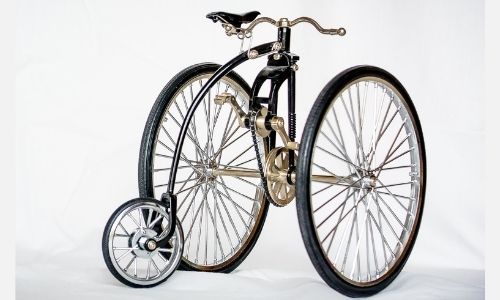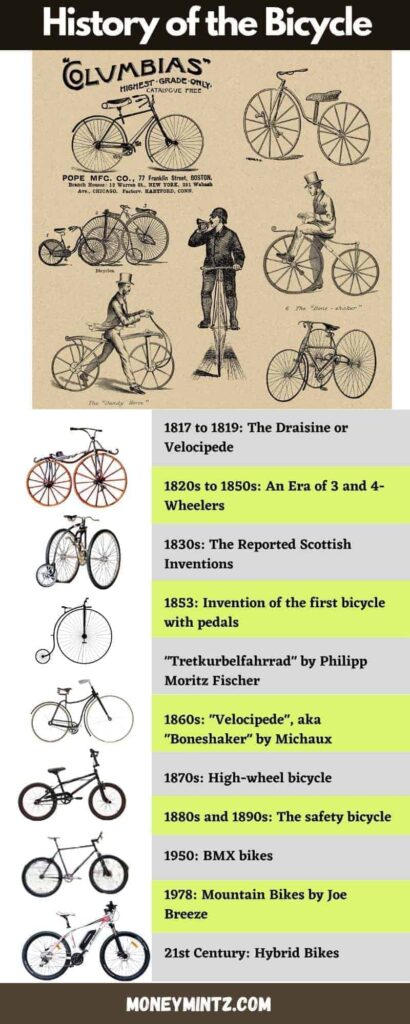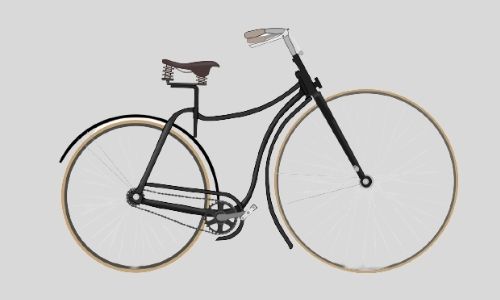The first primitively constructed devices known as bicycles were invented around 1817, in Paris by the Baron Karl de Drais de Sauerbrun. In 1879 the bicycle’s first wheel that had spokes made of wire was created by Armand Peugeot.
The style of the bicycle evolved not much since its first design, as seen in a model dating from 1952.
From the very beginning of bicycles to the more recent times, frames were constructed of steel and wood tubing. Mudguards, also known as fenders, along with chain guards were constructed out of leather. Wire-spoked wheel with pneumatic tires became common as was a derailleur hanger that was spoon-shaped at the rear of the axle to adjust the chain’s tension and clearance for various size prockets.
In 1958, tubular tires were introduced to replace the older “bone dome” style. It is important to note that only one of two types of derailleur hangers is illustrated.
The model was introduced one year later has more refinements to the design. The seat stays have been bent to offer more supple suspension. By this time, the sprocket’s cover was built into back fender.
The oldest drawing known of a bicycle was that was found in an French patent application that was filed on 17 March, 1818 (Application No. 56/117, which is now lost).

The drawing was created by the man who invented Derailleur Gear, Joseph Petitbled. The drawing depicts an upright bicycle that had two pedals joined via rods to a rear wheel that only had one sprocket, as there was no chain to drive the bigger rear sprocket.

Wooden Bicycle
The wooden bicycle designed by Jan Van Den Kerckhove in 1790 had two wheels joined via a frame but had there was no steering. A rider would push the front wheel to generate the steering torque on the front axle, which was steerable (a rotating front fork that had handles).
In 1839, French Army captain Pierre Michaux designed his own pedal bicycle. The bicycle was fitted with footrests, and the springs coiled on both sides to absorb the shocks caused by rough roads. The Michaux design did not prove extremely popular.
The rear wheel could not rotate, however the front wheel did through a connection rod.
In 1865, the engineer Eugène Meyer from Paris invented a bicycle with spheres made of steel within the hubs of each wheel. The spheres were placed in a slant to one another and functioned as ball bearings, which prevented any sideways motion of the hub with respect with the wheel.
Read: A Quick Biography of Winston Graham and Summary of Poldark Book Series
From 1869 to 1870, many innovations were invented, and it took years before the designs were able to catch up with the concepts that been a source of inspiration for Michaux and Van den Kerckhove. The pedals on the majority of bicycles were connected directly onto the crank (the “transmission” of modern bicycles) that was then was connected with the back wheel via an sprocket and chain.

Safety Bicycle
“Safety Bicycle”, developed in the 1880s, offered significant design improvements over its predecessors, the including tangent spokes that made it possible to use rims with smaller diameters. With no bumps caused by road imperfections, wheeling was more efficient and comfortable than riding on wheels.
The spokes that were tangent are less likely to crack and made the wheel more solid. A rubber wheel that was small and flexible was utilized in lieu of the rigid iron one.
In 1888, John Kemp Starley in the UK invented “the Rover Safety” Bicycle which was a bicycle that had an adjustable front wheel that included a suspension fork that allowed it to turn corners in a safe manner without becoming unstable.

In 1889, bicycle design was widely accepted as James Starley in Coventry patented “king-pin” or “dropped-handlebar” – this is held in place by bearings designed to support the load of the rider’s hand without causing additional force on bicycle’s other components during braking.
A French invention was made by Tricycles Daimler in 1887, but it wasn’t until 1889 that the French built a tricycle with pedals.
The circumference of the wheel of penny-farthings was around 50 inches (1.3 meters) and weighed around fifteen pounds (6.8 kg). They were dangerous to drive because of their poor brakes along with the difficult dismounting and mounting.
It was in 1878, that John Kemp Starley invented the Rover safety bicycle, a bicycle with a penny-farthing fork and front wheel but without a chain.
Read: Interesting Facts About Heather Locklear
The following year, he started selling the Rover Safety bicycles in his brother’s draper’s store in 1879. They were accessible to all who was able to ride. The concept was extremely successful as Starley’s Rover bicycles was selling all over the globe.
In 1891, almost all of the bicycle makers in Coventry began manufacturing safety bicycles such as John Kemp Starley’s Rover Safety model.
Pneumatic Tires
The pneumatic bicycle tire is believed to have been invented by Scotsman Robert William Thomson in 1845.
It was in 1887 that John Boyd Dunlop introduced the pneumatic tire to his son’s bicycle. It was an inner tube that was inflated, composed of rubber. This model had many advantages and quickly became a standard in the world of cycling (Dunlop is also believed to be responsible for inventing one of the first pneumatic tires designed for horses-drawn vehicles).
Energy utilization
The bicycle is extremely efficient at utilizing the energy humans generate under normal conditions. The energy generated by cyclists ranges between around 80-250 watts, according to the speed, weight and power applied to the pedals.
Mechanical efficiency can be described in terms of an efficient coefficient of performance (e-value) when cycling at different speeds. The e-value is a figure that has been calculated to be approximately 1.2 for cyclists and a bicycle. This means the only 12 percent energy used is absorbed by the bicycle/rider system, while the remaining (88 percent) is wasted due to frictional forces.
The actual figures of mechanical efficiency that are quoted above pertain to static conditions. In actual practice, most of the energy loss is because of moving move the bicycle, instead of due to pedal movement. The amount of power required by cyclists in order to deal with air resistance increases proportional to the square of the speed (double the speed – four times the power). So, climbing up hills get more difficult at higher speeds.
Harley-Davidson motorcycles
In 1895, Charles M. Higgins established what was later to be known as the Harley-Davidson Motor Company, to construct motorcycles.
In the 20th century, many bicycle types started competing on track comprised of loose, steep dirt tracks and hills. One of these styles is known as”Harley Davidson” due to the huge popularity of it among the owners of Harley-Davidson.
The year 1903 was the time that Hildebrand & Wolfmuller became the first production series motorcycle and was the first one to be known as a motorcycle.
Motor vehicle manufacturing came to prominence with numerous bicycle manufacturers However, many were not able to last through during the Great Depression.
It was 1953, when Japanese inventor Kenzo Tsujimoto created the first production motorcycle equipped with an “straight-twin” engine, using the same concept employed in motorcycles for 50 years before, but using specially designed engines for automobiles. In 1960, Yamaha introduced their first motorcycle, the YA-1 using the same engine design that Rokon had utilized in 1948.
Who are bicyclists?
Anyone who rides a bicycle called a bicyclist or cyclist and any vehicle that is driven on a track that is organized or at speed is referred to as a bicycle. Anyone who participates in an organized race according to the rules is also referred to as a bicyclist or cyclist.
Bicyclists vary in their abilities and frequently organize informal competitions to determine who is the best cyclist. Some riders are stunt riders such as BMX freestylers who use their bikes as a component of athletic skateboarding tricks, or by using the bike itself as the boards (BMX jumping) or by using the bike’s propulsion to perform an aerial move (BMX grinding).
Rules for bicycles/cyclists
In the UK, bicycles have to be licensed under a program that is administered through DVLA. This bans the use of pedal bikes on public roads as well as other public areas. To be legally able to use a bicycle on public roads, cyclists must be at fourteen years old or possess a valid licence for riding or driving. The majority of road bicycles have traditional, round-treaded bicycle tires with large rims.
It was believed that the level of comfort that recumbent bicycles could reduce cycling accidents who are involved in motor vehicle accidents that cause deaths or injuries. But more recent research suggests that there are no proofs to support this belief.
In the Netherlands bikes must be equipped with bells since traffic noise could cause people to be unable to hear traditional bells for bicycles.
Bicycles don’t require any specific type of clothing or accessories and can be used for traveling and leisure, riding trails, and for just having enjoyable. This frameset contains all kinds of bikes, including mountain bikes race bicycles, touring bikes, etc.
Health Benefits
Bicycles are very popular for recreational use for all different ages.
Cycling or biking on a bicycle offers numerous health benefits such as improved heart fitness, improved weight loss, lower stress levels, and lower blood pressure.
Studies have proven that those who cycle enjoy a longer life expectancy than those that don’t. It is believed that this is partly because of the benefits to health associated with cycling.
The motives behind cycling are numerous. There are many examples of this, including the pursuit of leisure, traveling and sports, or even commuting.
Utility Bike
A utility bike is often known as a city bike or a ‘commuter’. However, there isn’t much distinction between them apart from the tire treads of city bikes are typically constructed of a thicker rubber to ensure more durability. They are typically equipped with extras like pannier racks, mudguards, and lighting, which increases their utility on a daily basis.
Because the bicycle was utilized for work during the 19th century, there were numerous types of bicycles used by workers, with various specifications and designs.
A US manufactured “Chopper” bicycle, manufactured by Schwinn between 1969 and 1978. It is an example of utilitarian bicycle in use at the that time. It was a light Xtracycle, that can be used both as a bicycle or together with other components to create extended structures.
Racing Bicycles
BMX which is an abbreviation for Bicycle Moto Cross. It is usually associated with the popularity cycling in the US in the 1970s when it was made an Olympic sport, however the roots of BMX go back much earlier than the time of. It was founded in the 1950s when children started racing their bikes on dirt tracks throughout the southern part of California.
The first cycling motocross world championship held in 1974. Since then, a whole sport has developed to revolve around BMX Racing, with different kinds of bicycles and classes.
As of 2004, there are those who ride BMX as a means of transportation or as a pastime. In the lower classes of competition, tricks often involve riding around obstacles on the track such as stairs and jumps – basically an off-road version of freestyle tricks in flatland. A typical example would be pedaling from one side to another while giving the bike a 180 degree turn.
The most common procedure to run UCI events is that they complete several laps (1-5) on tracks that vary from 100m up to 1000m and sprints are held following each lap. The athletes who finish first to cross the finish line are the winners. There are often age categories in races and therefore the smallest riders (8 and less) start first, while the more experienced riders (14 and above) race later during the day.
Road cycling is a multi-disciplinary activity that is played all over the world and is gaining a large amount of popularity. Apart from its athletic aspect as a team and individual race, road cycling has been described as a means of transport or a competitive sport, and even an artistic form.
The majority of races are run on surfaces that are paved such as roads and tends to have long descents and climbs. Different disciplines are available with different rules, styles of bikes, and other equipment that could be utilized to enhance the performance of the bike in the race. Some examples include mass start events such as road racing, time trial races in which the riders race against clock.
Read: Life of Rowan Blanchard: Riley Matthews of Girl Meets World to Alexandra Cavill in Snowpiercer
There are many kinds of bikes that are used for various reasons, including transport tour, mountain biking as well as trick riding. In many regions of the world, this cycling infrastructure has been in place for a long time. This has resulted in a huge number of cyclists getting used to the infrastructure and riders choosing to ride responsible within it.
Velomobile
The Velomobile is also popular among a few European nations as a method to ride through all seasons and weather conditions. The velomobile can be described as an enclosed recumbent tricycle that has the occupant and the pedals sharing the same axis, to allow them to be turned toward each other in order to permit fast turns. The majority of them come with an aerodynamic fairing like the ones used by cycle-cars as well as motorcycles. They are usually fitted with small wheels that are on the outside of the fairing as well as large wheels inside.
The safety bicycle provided women with an unprecedented level of mobility, contributing to their emancipation in Western nations. It also helped to create a movement for rational clothes, that helped free women from ankle-length skirts and corsets and other restrictive clothing and replaced the bloomers.
First mechanical vehicle
Horse buggies and bicycles were the two primary means of private transport prior to the invention of the automobile. The development of roads with smooth surfaces in the latter half of the 19th century was spurred by the extensive advertisement, production and usage of these devices.
The first mechanically powered road vehicle might be built by Kirkpatrick MacMillan, a Scottish blacksmith, in 1839.
Prior to the dominance of the horseless carriage the most popular method of transportation in the early days was on horses or on foot.
The first vehicle powered by humans is believed to have been invented around 1869, by F. R. Simms, who constructed four-wheeled vehicle described as “a light road locomotive intended for the testing of such new methods and devices as may from time to time be introduced to facilitate the locomotion of carriages on common roads, or other roads.” The patent specification states that the model was fitted with a steering system, a wheel for driving, and three seating positions.
The Watt-steam Car
The first vehicle that was solely powered by electricity was developed in 1838 by chemical engineer Robert Davidson of Aberdeen, Scotland. “The “Watt steam car” is an automobile with three wheels that was developed and patent-protected around 1869, by Edinburgh inventor James Watt who devised the double-acting steam engine. The prototype remained in use until the creation of a replica in 1991 in California which led to a rise in enthusiasm for steam-powered automobiles.
Only eight models were produced by the French company Delamare-Deboutteville in 1909-1910, and they were used for many decades to deliver postcards and catalogues in France.
Invention of moden bicycle
The bicycle of today was invented at the end of the 19th century, mostly thanks to the efforts of individuals like John Kemp Starley, who produced his Rover safety bike in 1885.
The frame of modern bicycles is made to be stronger than it’s predecessor, the classic penny-farthing that had a limited capacity for acceleration.

The advent of mass production resulted in visually similar, and mechanically identical bicycles appearing on the market at drastically different price points while performing exactly as expected by their buyers. Bicycle manufacturers tended to emphasize style more than technology, leading to many advancements being made in bicycle frame design, but resulting in few advancements being made in the way the bicycle actually functions.
One such example of such advancement was the Penny Farthing or “Ordinary Bicycle” that was a significant step up from the traditional high wheel bicycle, allowing users to go at higher speed with lesser effort than had been feasible.
It was known as the Penny Farthing was also known as the “Ordinary Bicycle” and achieved its greatest popularity in 1880. It was defunct within one decade, replaced by the safety bicycle having wheels of the same dimensions (although not necessarily the same in style). Rear wheels are powered directly through a pedal crankset free to rotate through ball bearings. The larger wheel offered greater speeds, however it also had the increased area of its frontal surface made the balancing process more difficult.
Interesting Cases Surrounding Bicycles
Individual cyclists can join forces by joining clubs to demand improvements, like more roads. The story of bicycles is one of the technological innovations that came in response to the unmet demands.
The court records of 1869 indicate that a bicycle rider in Lexington, Kentucky was trying to convince the court that he hadn’t reached his destination when his bicycle was damaged because he monitored his speed each mile mark.
Conclusion
The bicycle is an invention that has changed the course of human history. It’s also one of the most popular modes of transportation on Earth today.
Whether you’re cycling to work, riding for fun with friends or racing competitively at a high level, there are some things about your bike that may surprise you.
You can check Britannica to know more about the history of bicycles.
We hope this article gives you new insights into bicycling and how it has changed people’s lives in many ways – not just as someone who rides bikes!
Related Articles:
- Master Self-Discipline: Transform Your Life in 2025 with These Essential Strategies!
- Ebook Design for Children’s Books: Capturing Young Minds Visually
- Expanding on the Value of Professional Fashion Design Services
- Get Custom African American Character Illustrations with Any Hairstyle
- Transform Your Look with Rasaline’s Expert Hairstyle and Fashion Advice



![What is Better — Translating English to Spanish or Spanish to English? [Analysis] 9 Translating English to Spanish or Spanish to English](https://moneymintz.com/wp-content/uploads/2021/10/Translating-English-to-Spanish-768x427.jpg)


